Introduction
Oxidative deterioration and rancidity is a major issue limiting the utilization of fatty oil. The rancidity leads to bad taste, discoloration, and nutritional degradation quality of the oil.1-2 Coconut oil is vegetable oil widely used for cooking in Southeast Asian countries, Srilanka, Brazil, and many countries in West Africa, North America, and Europe.3-4 Coconut oil relatively slow to oxidize and resistant to rancidification.5 However, during processing, such as frying and other heating, it may increase the oxidation and rancidification of fatty oil. Formation of several primary and secondary oxidation products such as lipid hydroperoxides, aldehydes, ketones, hydrocarbons, and alcohol found and may be harmful to human health.6-9
The addition of antioxidants is one of the most common ways to maintain the oxidative stability of fatty oil.10 Some synthetic antioxidants such as butyl-hydroxyanisole (BHA), butyl-hydroxytoluene (BHT), propyl gallate, and tert-butyl-hydroxyquinone (TBHQ) was frequently used.11 The synthetic antioxidants were used for a several reasons, includings inexpensive, high purity, and effectiveness.12 TBHQ (Figure 1) is the most commonly applied for fats and oils, especially vegetable oils,13 with a maximum level of use allowed is 0.02%.14 However, several studies indicated that chronic exposure of TBHQ might induce carcinogenicity. The semiquinone anion radicals derived from oxidized forms of TBHQ and reactive oxygen species (ROS) generation suggested contributing to that carcinogenic effects.15 Considering their potential toxicity of synthetic antioxidants, there is a growing demand to replace synthetic antioxidants with natural ones. However, the application still faces numerous challenges. The most important barrier is the economic cost.16-17 The introduction of new synthetic antioxidants produced cheaply and safer is another alternative that can be studied.12
Two aminomethyl derivatives of 2-methoxyphenol: 4,6-di[(morpholin-4-yl)methyl]-2-methoxyphenol (DMMMP) and 5-[(pyrrolidin-1-yl)methyl]vanillic acid (PMVA) (Figure 1) are new antioxidants successfully synthesized cheaply. This compound showed a free radical scavenger activity 300-437 folded than of vanillic acid used as starting material.18 However, their efficacy on enhancing thermal and oxidative storage stability of fatty oil and their biological safety has not been elucidated. Hence, this study aimed to evaluate the efficacy of DMMMP and PMVA as antioxidants on enhancing the stability of coconut oil during frying and storage.
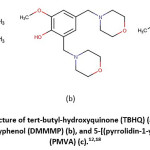 |
Figure 1: Chemical structure of tert-butyl-hydroxyquinone (TBHQ) (a), 4,6-di[(morpholin-4-yl)methyl]-2-methoxyphenol (DMMMP) (b), and 5-[(pyrrolidin-1-yl)methyl]vanillic acid (PMVA) (c).12,18 Click here to View figure |
Material and Methods
Materials
Fresh coconut oil was prepared traditionally by heating coconut flesh (Cocos nucifera) according to reported method.19 The coconut is picked from coconut tree garden in Bandar sub-district, Batang Regency, Central Java, Indonesia. The vegetable oil was analyzed to determine its suitability against Indonesian National Standard (ISN) 2902 (2011)20 concerning the characteristic standard of crude coconut oil. The organoleptic, water content, iodine value, free fatty acids level, peroxides value, and saponification value was assessed according to ISN 01-3555 (1998)21 method concerning evaluation oils and fats. 4,6-Di[(morpholin-4-yl)methyl]-2-methoxyphenol (DMMMP) and 5-[(pyrrolidin-1-yl)methyl]vanilillic acid (PMVA) were obtained from earlier reseacrher.18 Tertiary butyl hydroxyquinone (TBHQ), chemical reagents, and solvents were analytical grade and purchased from Sigma Aldrich, USA, or Merck, Germany.
Efficacy on Thermal Frying Stability
The efficacy of DMMMP and PMVA on thermal frying stability of coconut oil was carried out according to the frying stability method reported previously with a little modifications.3, 22-24 TBHQ is used as a comparative standard, and coconut oil without antioxidants was used as a negative control. Coconut oil is heated at a temperature of 180oC for 1, 3, and 6 hours. The concentration of DMMMP was 200, 350, and 500 ppm, PMVA was 200, 275, and 350 ppm, and TBHQ was 200 ppm. The following chemical parameters: free fatty acid (FFA) level (%), peroxide value (PV) (mEq peroxide/kg), and p-anisidine value (p-AV) were analyzed using reported procedure.8,22 FFA levels were determined by a volumetric titration technique using sodium hydroxide solution as a titer.8 The peroxide values (PV) were determined spectrophotometrically by measuring the absorption value of iron (III) chloride resulted from oxidation of iron (II) chloride by peroxide formed.25 While the p-anisidine value (p-AV) was determined by measuring spectrophotometrically, the amount of p-anisidine that reacts with the aldehyde compound formed.25
Efficacy on Storage Accelerated Stability
The efficacy of DMMMP and PMVA on the storage stability of coconut oil was carried out according to the accelerated stability method reported previously with a little modification.3,22-26 TBHQ is used as a comparative standard, and coconut oil without antioxidants is used as a negative control. Coconut oil with and without the addition of the antioxidants is stored at 60oC in the oven for nine weeks. The concentration of DMMMP was 200, 350, and 500 ppm, PMVA was 200, 275, and 350 ppm, and TBHQ was 200 ppm. Samples were taken at the week of 0, 2, 5, and 9 to be analyzed for their chemical parameters [free fatty acid (FFA) levels, peroxide value (PV), and p-anisidine value (p-aV)] using same procedures used in the thermal frying stability study mentioned above.8,25
Statistical Analysis
All determination were triplicated, and the reported data were the mean ± standard deviation (SD). The data were analyzed by one way ANOVA and Kruskal-Wallis methods with their statistical significance (p ≤ 0.05) using SPSS package (IBM, SPSS Statistics 21.0)
Result and Discussion
The result of the initial analysis indicated that the characteristic of coconut oil used for the study meets the Indonesian National Standard 2902 (2011).20 The crude oil presented as a specific smell and taste for coconut oil with a clear yellow colour. Water content, iodum value (IV), free fatty acid (FFA) level, peroxide value (PV), and saponification value (SV) of the oil were 0.2%, 7.0 g/100 g, 0.14%, 0.01 mEq peroxide/kg, and 269.5 mg KOH/g, respectively.
In this study, the efficacy of DMMMP and PMVA compared to TBHQ on thermal frying stability and storage oxidative stability of coconut oil was evaluated. The concentration for compound tested was applied based on the ratio between the IC50 value of radical DPPH scavenger activity of the compound tested, and TBHQ reported earlier.18 The concentration of TBHQ refers to a maximum level of use allowed.14
Efficacy on Thermal Frying Stability
Frying in high-temperature oil (around 180oC) is one of the most frequently used food processing methods. At high temperatures, the oil will underwent significant changes due to many chemical reactions occurred, such as hydrolysis, oxidation, isomerization, cyclization polymerization, and cyclization.7 The hydrolysis occurred was measured by free fatty acids (FFA) levels measurement. While the presence of oxidation was determined by the peroxide value (PV) measurement. Peroxide is unstable and will decompose to form aldehydes, ketones, alcohols, acids, and others. This secondary product leads to rancidity can be measured by the p-anisidin value (p-AV) method.8,25
Free Fatty Acid (FFA) Levels
An increase in free fatty acid (FFA) levels was detected at the 1st-hour observation in the control sample and samples that were added with DMMMP at concentrations of 200, 350, and 500 ppm. The samples with the addition of PMVA at concentrations of 200 and 275 ppm, no increasing of FFA levels observed until the 3rd hour, and the samples added with PMVA (350 ppm) or TBHQ (200 ppm) were not observed a significant increase in free fatty acids levels (Figure 2). These indicated that PMVA (350 ppm) dan TBHQ (200 ppm) could inhibit the hydrolysis of triglyceride to fatty acid on coconut oil. The results on the addition of TBHQ in this study are in line with the antioxidative effect of TBHQ on the thermal stability of sesame oil reported earlier.8
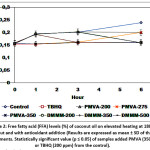 |
Figure 2: Free fatty acid (FFA) levels (%) of coconut oil on elevated heating at 180oC without and with antioxidant addition (Results are expressed as mean ± SD of three measurements. Statistically significant value (p ≤ 0.05) of samples added PMVA (350 ppm) or TBHQ (200 ppm) from the control). Click here to View figure |
Peroxide Value (PV)
The elevated heating at 180oC of the control sample and samples added with DMMMP or PMVA was observed a significant increase in the peroxide value (PV). While in the sample added with TBHQ, the increasing of PV was smaller than other samples (Figure 3). Based on the data above, it indicated that the DMMMP and PMVA could not delay peroxide formation in a frying temperature of 180o C of coconut oil. According to previous reports, the antioxidative effect of TBHQ decreased significantly at temperatures ≥ 135oC,13 but our study indicated that it didn’t show a decrease.
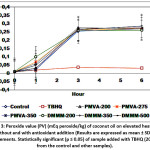 |
Figure 3: Peroxide value (PV) (mEq peroxide/kg) of coconut oil on elevated heating at 180oC without and with antioxidant addition (Results are expressed as mean ± SD of three measurements. Statistically significant (p ≤ 0.05) of sample added with TBHQ (200 ppm) from the control and other samples). Click here to View figure |
p-Anisidine Value (p-AV)
At the 3rd and 6th hours after high-heating at 180oC, the control sample, the sample added with DMMMP with a concentration of 200, 350, and 500 ppm, and sample added with PMVA with the concentration of 200 ppm and 275 ppm were observed the increasing of p-AV significantly. Whereas the sample added with TBHQ (200 ppm) or PMVA (350 ppm) showed p-AV relatively stable (Figure 4). Based on this result indicated that DMMMP at all concentrations and PMVA at a concentration of 200 ppm and 275 ppm, did not have a better effect compared to PMVA (350 ppm) and TBHQ (200 ppm) in the secondary oxidation product formation of coconut oil.
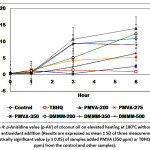 |
Figure 4: p-Anisidine value (p-AV) of coconut oil on elevated heating at 180oC without and with antioxidant addition (Results are expressed as mean ± SD of three measurements. Statistically significant value (p ≤ 0.05) of samples added PMVA (350 ppm) or TBHQ (200 ppm) from the control and other samples). Click here to View figure |
Efficacy on Storage Accelerated Stability.
Oxidative stability is a test to determine the storage duration until rancidity is formed. Tests carried out under normal conditions can determine realistic stability. However, testing in this condition requires a very long time, so in this study, the accelerated storage test method was performed using the Schaal oven test method.25 An increase in temperature was increasing an oxidation reaction that can be evaluated both organoleptically and chemically.
Free Fatty Acid (FFA) levels
The FFA levels in the control sample, sample added with DMMMP (200 ppm), DMMP (350 ppm), PMVA (200 ppm), and PMVA (275 ppm) increased from week 1 to week 5. Whereas the sample added with DMMMP (500 ppm), the increasing began to occur after the 1st week, and in sample added with PMVA (350 ppm), an increase in FFA levels occurred after the 2nd week. Samples with the addition of TBHQ (200 ppm) showed the FFA levels that were stable until the 5th week (Figure 5). The above data indicate that the effectiveness of TBHQ in inhibiting triglyceride hydrolysis was higher than DMMMP and PMAV.
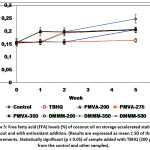 |
Figure 5: Free fatty acid (FFA) levels (%) of coconut oil on storage accelerated stability without and with antioxidant addition. (Results are expressed as mean ± SD of three measurements. Statistically significant (p ≤ 0.05) of sample added with TBHQ (200 ppm) from the control and other samples). Click here to View figure |
Peroxide Value (PV)
PV is the general method for determining the oxidative stability of oils. The amount of peroxide formed indicates the degree of primary oxidation associated with rancidity.6-9 An increase in PV indicated the formation of hydroperoxide during the lipid oxidation process. In the study, the control sample underwent an increase in the PV during storage at week 0 to week 5. The PV of the DMMMP sample has increased at the 2nd week of storage, while the sample with PMAV and TBHQ can withstand the PV until the 5th week (Figure 6). It indicated that PMAV and TBHQ could delay peroxide formation in the storage.
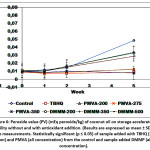 |
Figure 6: Peroxide value (PV) (mEq peroxide/kg) of coconut oil on storage accelerated stability without and with antioxidant addition. (Results are expressed as mean ± SD of three measurements. Statistically significant (p ≤ 0.05) of sample added with TBHQ (200 ppm) and PMVA (all concentration) from the control and sample added DMMP (all concentration). Click here to View figure |
p-Anisidine Value (p-AV)
In all samples, there was an increase in p-AV in the second-week storage. The increase in p-AV in the sample with the addition of TBHQ was not as high as in the other samples (Figure 7). However, this difference was not significant.
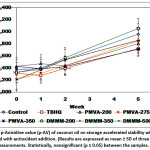 |
Figure 7: p-Anisidine value (p-AV) of coconut oil on storage accelerated stability without and with antioxidant addition. (Results are expressed as mean ± SD of three measurements. Statistically, nonsignificant (p ≤ 0.05) between the samples. Click here to View figure |
Conclusion
Evaluation of the efficacy of antioxidants of two aminomethyl derivatives of 2-methoxyphenol: 2-methoxy-4,6-di[(morpholin-4-yl)methyl]phenol (DMMMP) and 5-[(pyrrolidin-1-yl)methyl]vanillic acid (PMVA) compared to tert-butyl hydroxy quinone (TBHQ) against oxidative stability during frying and storage of coconut oil has been done successfully. Free fatty acid level, peroxide value, and p-anisidine value were used as parameters to assess the level of oxidative stability of the oil with and without the addition of antioxidants. The results indicated that the efficacy of PMVA as an antioxidant against thermal and storage oxidative stability of coconut oil is higher than DMMMP but lower than TBHQ.
Acknowledgments
We are grateful to the Dean of the Faculty of Pharmacy, Universitas Indonesia, for granting permission to use all laboratory facilities to perform this study. We thank Prof. Yahdiana Harahap and Prof. Arry Yanuar for useful discussion
Funding Source
The financial for this work was supported by Universitas Indonesia, Depok, Indonesia (PITTA B, 2019).
Conflict of Interest
The authors declare that there is no conflict of interest.
References
- Maszewska M., Florowska A., Dłużewska E., Wroniak M., Marciniak-Lukasiak K., Żbikowska A. (2018). Oxidative Stability of Selected Edible Oils. Molecules, 2018; 23(7): 1746.
- Rohman A., Che Man Y.B., Ismail A., Hashim P. Monitoring the oxidative stability of virgin coconut oil during oven test using chemical indexes and FTIR Spectroscopy. Int Food Res J. 2011;18: 303-310.
- Chandran J., Nayana N., Roshini N., Nisha, P. Oxidative stability, thermal stability and acceptability of coconut oil flavored with essential oils from black pepper and ginger. J Food Sci and Technol, 2017;54(1):144-152.
- Boateng, L., Ansong, R., Owusu, W. B., & Steiner-Asiedu, M. Coconut oil and palm oil’s role in nutrition, health and national development: A review. Ghana Med J. 2016; 50(3):189–196.
- Moigradean, D., Poiana, M-A., Gogoasa, I. Quality characteristics and oxidative stability of coconut oil during storage. J Agroaliment Proc Technol. 2012; 18(4): 272-276
- Banerjee R., Verma A.K., Siddiqui M.W. Natural antioxidants: Applications in foods of animal origin. Toronto: Apple Academic Press, 2017.
- De Alzaa F., Guillaume C., Ravetti, L. Evaluation of Chemical and Physical Changes in Different Commercial Oils during Heating. Acta Sci Nutr Health. 2018;2(6): 2-11.
- Prasad N., Siddaramaiah,Ba nu, M. Effect of antioxidant tertiary butyl hydroquinone on the thermal and oxidative stability of sesame oil (sesamum indicum) by ultrasonic studies. J Food Sci Tech. 2014;52(4), 2238-2246.
- Evuen U.F, Apiamu A., Ugbeni, O.C. Toxicological Potentials of Repeated Frying on Antioxidant Status of Vegetable Oils. Int J Eng Res Tech. 2013;2(3):1-6.
- Chaiyasit W., Elias R.J., McClements, D.J., Decker, E.A. Role of Physical Structures in Bulk Oils on Lipid Oxidation. Critical Rev in Food Sci and Nutr. 2007;47(3): 299–317.
- Gülçin İ., Elmastaş M., Aboul-Enein, H.Y. Antioxidant activity of clove oil – A powerful antioxidant source. Arabian J Chem. 2012;5(4): 489–499.
- Berdahl D.R, Nahas R.I., Barren J.P. (2010). Synthetic and natural antioxidant additives in food stabilization: current applications and future research. In Oxidation in Foods and Beverages and Antioxidant Applications. Woodhead Publishing Series in Food Science, Technology and Nutrition, p 272-320. https://www.sciencedirect.com/science/article/pii/B9781845696481500125
- Liu C., Li J., Bi Y., Wang X., Sun S., Yang G. Thermal Losses of Tertiary Butylhydroquinone (TBHQ) and its Effect on the Qualities of Palm Oil. J Oleo Sci. 2016;65(9):739-748.
- (2017). TBHQ. Available at ://www.accessdata.fda.gov/scripts/cdrh/cfdocs/cfcfr/CFRSearch.cfm?fr=172.185 (accessed on Mei 3, 2019)
- Gharavi N., Haggarty S., El-Kadi, A.O.S. Chemoprotective and carcinogenic effects of tert-butylhydroquinone and its metabolites. Curr Drug Metab. 2007; 8: 1-7.
- Taghvaei M., Jafari S.M. (2015). Application and stability of natural antioxidants in edible oils in order to substitute synthetic additives. J Food Sci Technol. 52(3):1272–1282
- Raikos V. (2017). Natural Antioxidants for Food Applications: Challenges and Recent Developments. EC Nutrition 8 (2): 33-34.
- Hayun H., Gavrila I., Silviana S., Siahaan A.E.K, Vonna R.F., Latifah M.I. Synthesis and Antioxidant Activity Study of New Mannich Bases Derived from Vanillic Acid. Rasayan J Chem., 2020;13(1): 131-138.
- Setiaji B., Surip P.. Membuat VCO Berkualitas Tinggi. Jakarta: Penebar Swadaya, 2006.
- Standar Nasional Indonesia. Minyak Kelapa. Jakarta: Badan Standardisasi Nasional, Indonesia, 2011.
- Standar Nasional Indonesia. Cara uji minyak dan lemak. Jakarta: Badan Standardisasi Nasional, Indonesia, 1992
- Srivastava Y., Semwal A.D. A study on monitoring of frying performance and oxidative stability of virgin coconut oil (VCO) during continuous/prolonged deep fat frying process using chemical and FTIR spectroscopy. J Food Sci Technol, 2015; 52(2):984–991.
- Trivedi V., Nivetha Y., Chow P.Y.E. Improving the frying performance of RBD palm olein oil using Natur FORTTM TRLG 101 liquid as on-top of TBHQ in deep-fat frying of potato chips. J Food Sci Technol, 2017; 54(12):4035–4041.
- Sharoba A.M., Ramadan M.F. Impact of Frying on Fatty Acid Profile and Rheological Behaviour of Some Vegetable Oils. J Food Process Technol, 2012, 3:161.
- Mohanan A., Nickerson M.T., Ghosh S. (2018). Oxidative stability of flaxseed oil: effect of hydrophilic, hydrophobic and intermediate polarity antioxidants. Food Chem. 2018;266:524–533.
- Easman (2010). Schaal Oven Storage Stability Test. Evaluating antioxidant effectivenes in fats, oil, and fat-containing foods. https://www.eastman.com/Literature_Center/Z/ZG194.pdf

This work is licensed under a Creative Commons Attribution 4.0 International License.







